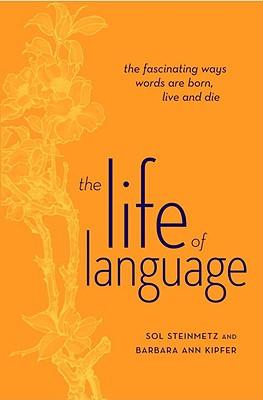Overview
"If time travelers from the nineteenth century dropped in on us, our strange vocabulary would shock them just as much as our TVs, cars, and computers. Society changes, and so does its word stock. ""The Life of Language"" reveals how pop culture, business, technology, and other forces of globalization expand and enrich the English language, forming thousands of new words every year. In this fascinating and jargon-free guide, lexicographers Kipfer and Steinmetz reconstruct the births of thousands of words, including ""infantries, poz, mobs, Soho, dinks, choo choos, frankenfoods, LOL, narcs ""and ""perps."" . A word lover s guide to etymology, written in a fun, informal, and accessible style. An excellent resource for vocabulary building; a word's root helps readers understand its meaning. Beautifully packaged paperback with French flaps"""
Full Product Details
Author: Barbara Ann Kipfer ,
Sol Steinmetz
Publisher: Random House USA Inc
Imprint: Random House USA Inc
Dimensions:
Width: 14.00cm
, Height: 2.10cm
, Length: 20.80cm
Weight: 0.435kg
ISBN: 9780375721137
ISBN 10: 0375721134
Pages: 388
Publication Date: 01 July 2006
Audience:
General/trade
,
General
Format: Paperback
Publisher's Status: Unknown
Availability: In Print

Limited stock is available. It will be ordered for you and shipped pending supplier's limited stock.
Reviews
"""The Life of Language, "" subtitled the fascinating ways words are born, live and die, by Sol Steinmetz and Barbara Ann Kipfer (Random House trade paperback, $17). This scholarly but easy-to-breeze-through introduction to the world of words, written by a pair of crack lexicographers (Sol is a longtime mentor of On Language), ranks as the linguistic bargain of the year. From baby talk to back-formation, from minting new words to functional shift, the subjects are treated with amusing erudition. The chapter on reduplication flip-flopping higgledy-piggledy through the riffraff differentiates rhyming compounds like ""bigwig, hotshot, ragtag, sci-fi ""from repetitions called tautonyms, such as ""bye-bye, so-so, rah-rah, "" as well as from ricochet words in which the repeated element is modified: ""chit-chat, roly-poly, shilly-shally."" They reveal the source of the schm-/shm- reduplication, from the Yiddish koyfn, shmoyfn, To buy, not to buy, who cares? This construction led to the adoption in English of fancy-schmancy to mean pretentious and to the jocular derogation of a host of words and names ( Oedipus, schmoedipus as long as he loves his mother ). Boinng!--William Safire, ""The New York Times,"" December 3, 2006"""
The Life of Language, subtitled the fascinating ways words are born, live and die, by Sol Steinmetz and Barbara Ann Kipfer (Random House trade paperback, $17). This scholarly but easy-to-breeze-through introduction to the world of words, written by a pair of crack lexicographers (Sol is a longtime mentor of On Language), ranks as the linguistic bargain of the year. <br>From baby talk to back-formation, from minting new words to functional shift, the subjects are treated with amusing erudition. The chapter on reduplication - flip-flopping higgledy-piggledy through the riffraff - differentiates rhyming compounds like bigwig, hotshot, ragtag, sci-fi from repetitions called tautonyms, such as bye-bye, so-so, rah-rah, as well as from ricochet words in which the repeated element is modified: chit-chat, roly-poly, shilly-shally. <br>They reveal the source of the schm-/shm- reduplication, from the Yiddish koyfn, shmoyfn, To buy, not to buy, who cares? This construction led to
The Life of Language, subtitled the fascinating ways words are born, live and die, by Sol Steinmetz and Barbara Ann Kipfer (Random House trade paperback, $17). This scholarly but easy-to-breeze-through introduction to the world of words, written by a pair of crack lexicographers (Sol is a longtime mentor of On Language), ranks as the linguistic bargain of the year. <br>From baby talk to back-formation, from minting new words to functional shift, the subjects are treated with amusing erudition. The chapter on reduplication - flip-flopping higgledy-piggledy through the riffraff - differentiates rhyming compounds like bigwig, hotshot, ragtag, sci-fi from repetitions called tautonyms, such as bye-bye, so-so, rah-rah, as well as from ricochet words in which the repeated element is modified: chit-chat, roly-poly, shilly-shally. <br>They reveal the source of the schm-/shm- reduplication, from the Yiddish koyfn, shmoyfn, To buy, not to buy, who cares? This construction led to the adoption in English of fancy-schmancy to mean pretentious and to the jocular derogation of a host of words and names ( Oedipus, schmoedipus - as long as he loves his mother ). Boinng!<br>--William Safire, The New York Times, December 3, 2006
Author Information
"Barbara Ann Kipfer is a lexicographer, archaeologist, and the author of more than 25 books, including ""How it Happens, 4,000 Questions for Getting to Know Anyone and Everyone, 14,000 Things to Be Happy About,"" and ""The Order of Things."" Sol Steinmetz is a well-known lexicographer and former editor in chief at Random House Reference."""




